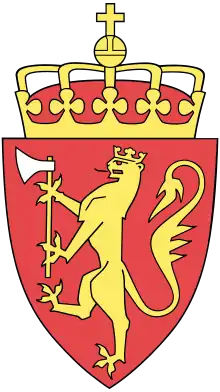Heim (former municipality)
Heim is a former municipality in the old Sør-Trøndelag county in Norway. The 271-square-kilometre (105 sq mi) municipality existed from 1911 until its dissolution in 1964. The municipality encompassed the northern part of what is now Heim and Orkland municipalities and the southeastern part of Hitra municipality in Trøndelag county. The administrative centre was the village of Heim where Heim Church is located.[2]
Heim herred | |
|---|---|
 View of the mountain Heimsfjellet | |
 Sør-Trøndelag within Norway | |
 Heim within Sør-Trøndelag | |
| Coordinates: 63.4238°N 09.0932°E | |
| Country | Norway |
| County | Sør-Trøndelag |
| District | Fosen |
| Established | 1 Jan 1911 |
| Disestablished | 1 Jan 1964 |
| Administrative centre | Heim |
| Area | |
| • Total | 271 km2 (105 sq mi) |
| *Area at municipal dissolution. | |
| Population | |
| • Total | 1,435 |
| • Density | 5.3/km2 (14/sq mi) |
| Demonym(s) | heimsbygg[1] |
| Time zone | UTC+01:00 (CET) |
| • Summer (DST) | UTC+02:00 (CEST) |
| ISO 3166 code | NO-1614 |
| Preceded by | Hemne in 1911 |
| Succeeded by | Hemne and Snillfjord in 1964 |
History
Originally (since 1838) the municipality was a part of the municipality of Hemne (see formannskapsdistrikt law). On 1 January 1911, the large municipality of Hemne was divided into two: Hemne (population: 3,425) in the south and Heim (population: 1,533) in the north. During the 1960s, there were many municipal mergers across Norway due to the work of the Schei Committee. On 1 January 1964, Heim ceased to exist as a municipality. The district of Vestre Heim (Western Heim, the area west of the Hemnefjord) with its 711 inhabitants was merged with the neighboring municipalities of Hemne and Vinje to form a new, larger Hemne municipality. At the same time, the district of Austre Heim (Eastern Heim, the area east of the Hemnfjorden) with its 724 residents was merged with the neighboring municipality of Snillfjord and part of the municipality of Agdenes to become a new, larger municipality of Snillfjord.[3]
Name
The parish of Heim was established in 1884. It is named after the old Heim farm (Old Norse: Heimr), since the Heim Church is built on its ground. The name is identical with the word heimr which means "home", "homestead", or "farm".[4]
Government
All municipalities in Norway, including Heim, are responsible for primary education (through 10th grade), outpatient health services, senior citizen services, unemployment and other social services, zoning, economic development, and municipal roads. The municipality is governed by a municipal council of elected representatives, which in turn elects a mayor.[5]
Municipal council
The municipal council (Herredsstyre) of HeimHeim was made up of 13 representatives that were elected to four year terms. The party breakdown of the final municipal council was as follows:
| Party Name (in Norwegian) | Number of representatives | |
|---|---|---|
| Labour Party (Arbeiderpartiet) | 3 | |
| Local List(s) (Lokale lister) | 10 | |
| Total number of members: | 13 | |
| Party Name (in Norwegian) | Number of representatives | |
|---|---|---|
| Labour Party (Arbeiderpartiet) | 2 | |
| Local List(s) (Lokale lister) | 11 | |
| Total number of members: | 13 | |
| Party Name (in Norwegian) | Number of representatives | |
|---|---|---|
| Labour Party (Arbeiderpartiet) | 2 | |
| Local List(s) (Lokale lister) | 10 | |
| Total number of members: | 12 | |
| Party Name (in Norwegian) | Number of representatives | |
|---|---|---|
| Labour Party (Arbeiderpartiet) | 2 | |
| Local List(s) (Lokale lister) | 10 | |
| Total number of members: | 12 | |
| Party Name (in Norwegian) | Number of representatives | |
|---|---|---|
| Local List(s) (Lokale lister) | 12 | |
| Total number of members: | 12 | |
| Party Name (in Norwegian) | Number of representatives | |
|---|---|---|
| Labour Party (Arbeiderpartiet) | 3 | |
| Joint List(s) of Non-Socialist Parties (Borgerlige Felleslister) | 9 | |
| Total number of members: | 12 | |
References
- "Navn på steder og personer: Innbyggjarnamn" (in Norwegian). Språkrådet.
- Haugen, Morten, ed. (2009-02-14). "Heim". Store norske leksikon (in Norwegian). Kunnskapsforlaget. Retrieved 2018-02-11.
- Jukvam, Dag (1999). "Historisk oversikt over endringer i kommune- og fylkesinndelingen" (PDF) (in Norwegian). Statistisk sentralbyrå.
- Rygh, Oluf (1901). Norske gaardnavne: Søndre Trondhjems amt (in Norwegian) (14 ed.). Kristiania, Norge: W. C. Fabritius & sønners bogtrikkeri. p. 85.
- Hansen, Tore, ed. (2016-05-12). "kommunestyre". Store norske leksikon (in Norwegian). Kunnskapsforlaget. Retrieved 2020-02-02.
- "Kommunevalgene og Ordførervalgene 1959" (PDF) (in Norwegian). Oslo: Statistisk sentralbyrå. 1960. Retrieved 2020-04-20.
- "Kommunevalgene og Ordførervalgene 1955" (PDF) (in Norwegian). Oslo: Statistisk sentralbyrå. 1957. Retrieved 2020-04-20.
- "Kommunevalgene og Ordførervalgene 1951" (PDF) (in Norwegian). Oslo: Statistisk sentralbyrå. 1952. Retrieved 2020-04-20.
- "Kommunevalgene og Ordførervalgene 1947" (PDF) (in Norwegian). Oslo: Statistisk sentralbyrå. 1948. Retrieved 2020-04-20.
- "Kommunevalgene og Ordførervalgene 1945" (PDF) (in Norwegian). Oslo: Statistisk sentralbyrå. 1947. Retrieved 2020-04-20.
- "Kommunevalgene og Ordførervalgene 1937" (PDF) (in Norwegian). Oslo: Statistisk sentralbyrå. 1938. Retrieved 2020-04-20.

